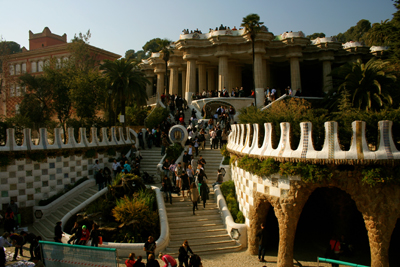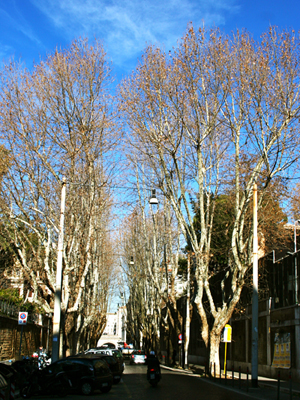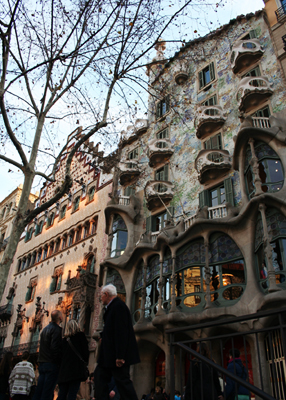Street Trees – The staple of European urban forests
For the most part, in Barcelona, street trees are the predominant urban tree. The majority of land is covered in apartments and condo spaces - backyards are not easy to come by. So the street trees that decorate and shade Barcelona’s urban road ways are that much more important.
But as I moved though Barcelona’s parks, which cover 10% of the city, I discovered many other beautiful places where you can take a leafy green breather. One park not to be missed is the incredibly popular, Antoni Gaudí’s Park Güell, pictured below

Biodiversity… What’s that?
I thought I would travel across the world and be bewildered by all the new species of trees I would see but was quite surprised to find the London Plane tree EVERYWHERE! I don’t have any true figures but to me it seemed that the London Plane could have easily made up 70% or more of Barcelona’s canopy. There are two possible reasons for this.
They Handle Urban Stresses Well: London Plane trees do well in urban conditions, are tolerant of atmospheric pollution and can stand up to compaction.

A typical boulevard in Rome.
They are beautiful: In Toronto we see these trees used more and more on our boulevards but many of them are still quite young. In Barcelona and around Rome these trees are mature; their crowns create stunning archways over their streets and walkways.

London Plane standing in front of the Casa Batllo
You can almost imagine that the colours, patterns, shapes and forms of the London Plane inspired the astonishing beauty in Gaudi’s Casa Batllo.
Pruning and some interesting haircuts…
In Barcelona and Rome, both municipalities seemed to regularly practice a type of pruning called pollarding. Pollarding is a very old and specialized practice of aboriculture that cuts back tree crowns to specific points on branches where pollard heads are formed. This pruning is done every so many years to maintain the stylized shape, but was originally done to create kindling for the tree owner’s families. To the untrained eye, pollarding would appear much like topping of a tree, but in actuality it is very different.
Topping a tree causes a multitude of replacement branches to form from where the cut was made, which creates a weak point within the branching and compromises the trees structural integrity over time. Pollarding is only done to certain tree species to ensure the trees structure will remain strong. The cuts made to create a pollard tree are very specific and the branches that remain are chosen for their strength and shaping.
The maintenance cuts are made at the exact same place on the branch time and time again to create the pollard head. When the crown grows back after such cuts, it creates a beautifully unique canopy for the urban environment. This practice is very popular in Europe, but the art has been mostly lost in North America.
Overall I was stunned by the vast differences between the old European style cities and the more modern one I call home. The heavy grey infrastructure, though rich in history, leaves little – and sometimes no space at all for the beautiful green we take for granted. This trip really did make me appreciate my own tiny plot of soil behind my apartment where I have a native species shade garden and a small food garden. More than anything it is a place where I can always take my own leafy green breather.
You can read more about the next half of my trip - which took me to North Africa - in my next post.
On Thursday, August 16, 2012 we held a talk at Metro Hall titled "International Influences: Inspiring ideas for trees in public space". Led by Brendan Stewart, Landscape Architect and Urban Designer at ERA Architects, it explored the ways we can borrow ideas, concepts and philosophies from other cities and bring them home to our own urban forests. In celebration of this theme, we launched a blog series where we reflect on the how forests from around the globe have inspired us. This is one of those stories.Watch this space for more in the series.
